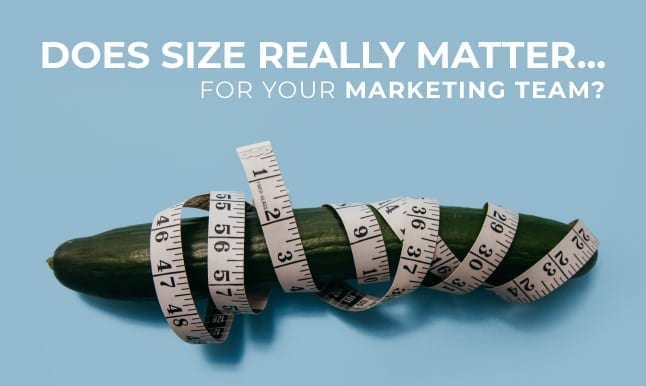Whether you work at a small bootstrapping non-profit or a large multinational company, at some point your marketing team struggles with the same age-old question: Does size matter? Does the size of your team and the different roles each person has matter?
Folks arrive at this question when they’ve run out of ideas, when their budget is exhausted, they aren’t seeing the results they wanted, or when they are scaling and have the budget to go higher. Lots of reasons bring people to this point, but rarely does each company come out with a remotely similar answer.
There are plenty of tools to help you determine what size team you need. But how the hell are they able to learn all about your business with a simple calculator? They don’t know you or your company and would struggle to learn what makes you tick without getting involved.
Here at Design Pickle, we’ve struggled just like other businesses to determine the best way forward with our marketing team (really all of our teams) and what the hell it looks like.
Do you need a social media coordinator…or 3?
Should you outsource the whole thing to an agency or to a bunch of consultants? If you do that, wouldn’t you just be outsourcing your vision?
We wrestled with these questions as recently as last quarter and we realized that the best way to figure this out involves a few very simple steps.
1. Do you know SPECIFICALLY what you need?

Most folks recognize the need and importance of marketing, but they don’t know where to begin. Marketing as a category is wide and diverse.
Social media marketing, guerilla marketing, traditional marketing, the list goes on. Is your marketing plan tied into a continual sales strategy or are you just looking to market in the hopes that your billboard will get you the $1,000,000 you need this month?
Bring together your leadership team or the stakeholders involved with the marketing team and have a very frank conversation about where you are and what your goals are. If you can’t simply say what you need and what you’re looking for, you’ll never be able to pick the right strategy.
If your goals aren’t defined or clear, this will affect the decisions you make, and the people you bring on board. Chances are, the person you’ll end up choosing will be a bad fit – or worse – it will really screw up your long-term game plan, losing money and momentum.
2. Engage your mission, vision, and values.

To ensure you don’t lose your way, you’ve got to have a simple, sound, and sexy mission, vision, and values statements. Design Pickle is a company that thrives because of our values. We strive to embody and express them daily, during every meeting, with every team.. If we don’t, decisions we make can cause us to lose our stride.
Our values are simple: We believe in being smart working, truthful, service oriented, and friendly.
EVERYTHING we do must echo this. If the person we want to bring in doesn’t embody these, we can’t use them because they’ll ruin our long-term mission of being the most helpful creative company in the world.
3. Remember that this is a marathon, not a sprint.

The easiest way to kill a business is to forget the long-term goals you have. Around here, we call that “having a scarcity mindset”.
Having an overly acute, limited view or scope will cause you to be very shortsighted in how you approach things. It will cause you to hurry and make decisions that will start fires down the road. Instead, be informed and operate from a place of abundance.
If you find yourself really struggling to accomplish your goals and hit your targets, take the time to reflect, analyze, and report your findings as to why. Make your course corrections quickly and know that the higher your decision velocity is the more you’ll learn and ultimately correct, which will lead to growth.
4. To specialize or generalize?

When it comes to the size of your marketing team, what each person is responsible for is an important task to consider. Generally, the smaller your team, the larger the share of tasks and responsibilities on each person. Conversely, the larger the team, the smaller the share of tasks. Of course, it’s not THAT simple of an algorithm.
A smaller team is easier to manage and communicate with. With a smaller team, agility and speed to react are probably better. However, the load on each member is bigger. What happens if a team member leaves? The replacement will be responsible for a large and crucial piece of the pie.
With a bigger team, you can spread tasks out, each person doing less. More focus, fewer mistakes. Of course, managing that team can be more difficult. Bureaucracy often develops with larger teams. Communication can become muddled. Some say personal buy-in may be lower with a larger team as well.
Conclusion
George Fasching wrote a fascinating article about team size dynamics, really getting into some interesting ideas about team size and performance. George leans towards the “smaller is better” philosophy.
Teams of less than 20 tend to be more effective unless you only have a team of 8. Which is random yet has been proven to be problematic, especially when it comes to decision-making deadlock. The U.S. Marines believe the best size of the basic fighting unit, the “fire team”, is 4.

Another point.
When growth IS necessary, you must also become aware of how adding team members can affect the team. Culture fit, responsibility shift, logistics regarding onboarding and training are really important to consider.
At Design Pickle, almost EVERY new employee spends time on the Customer Success team. We jokingly refer to it as the CS Internship. This internship is a fantastic way for our new team members to get real, hands-on experience in the DP trenches. However, any addition to the team, even temporary, can affect the dynamic. Thanks to Kevin and Amanda for being so patient and accommodating!
The same thing could be said about shrinking a team. Reducing members also have a real impact on a team’s performance, especially if the reduction was not anticipated.
Deciding to have a team of 1 or 50 is completely up to you, but make sure that you’re using the right tools and strategy.








